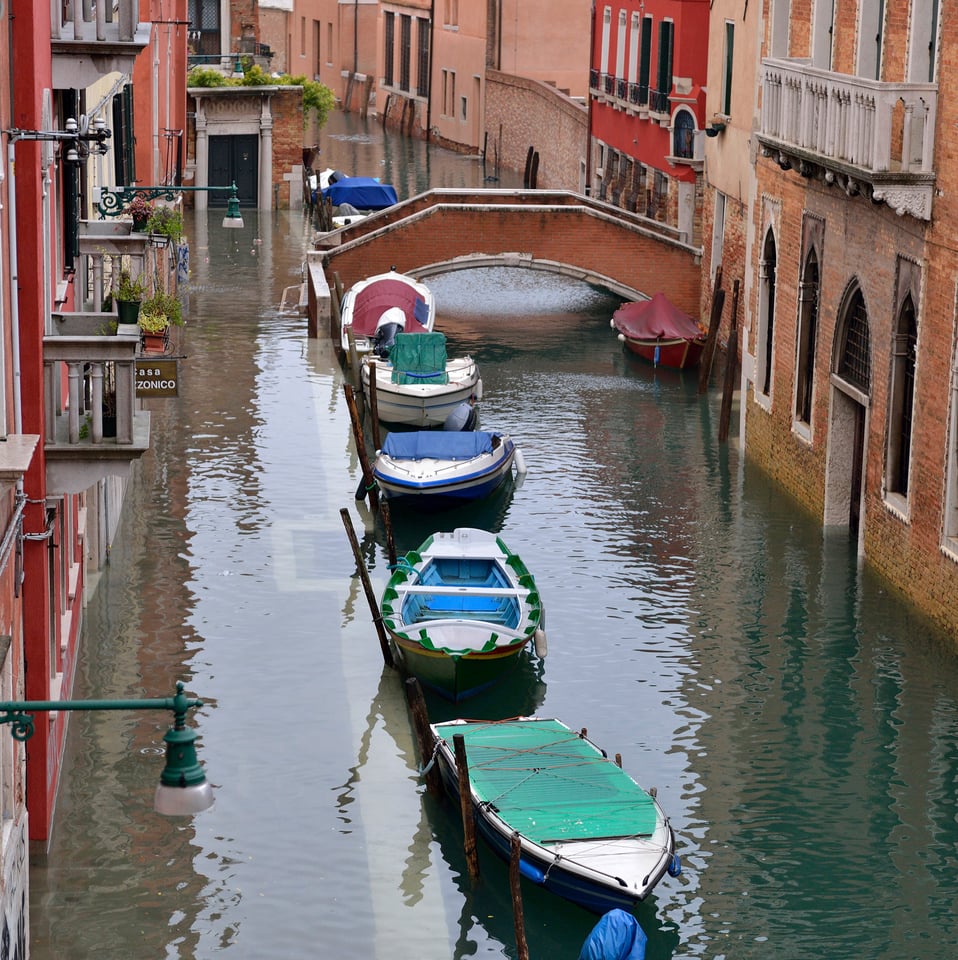Until it disappears… Some while ago there was a post by Talha Najeeb, claiming Paris to be the most beautiful city in the world. To which my response was, “I’m sure Venice would have something to say about that”. Yes, Paris is certainly gorgeous, but Venice – well, there’s only one “La Serenissima”.
Time to let the photos do the talking:

Venice is unique in a couple of respects. The first is pretty obvious – it is built entirely on a series of small islands, enclosed in a lagoon, so there are no roads, and no automobiles. This doesn’t mean there are no traffic jams:

Secondly, the entire historic city is pretty much intact. There are a few new buildings at the margins, but modest in scale and style. Apart from a small handful of buildings in the centre, a visitor from the sixteenth century would recognize pretty much everything. It’s said there was a tacit agreement between the warring powers in WW2 that wherever else they bombed, Venice would not be touched:

In its heyday, Venice was a major maritime power, and for centuries controlled much of the trade between East and West. Trade and diplomatic visitors arrived at Piazza San Marco. The Piazza, the Doges Palace, and San Marco basilica were built to impress and overwhelm, and they still do:

Trying to get a decent shot of the front of San Marco – without either scaffolding or crowds of tourists – is pretty much impossible. Shooting the interior isn’t much easier since photography is not allowed, but just to give you an idea:

Yes, the entire place is covered in gold mosaic. The wealthy merchants of Venice splashed their cash on the beautiful palazzi which line the canals, especially of course, the Grand Canal:

Most of the visitors (and yes, there plenty of them, even in low season, which is when all my shots were taken) are day-trippers, who arrive, spend a quick day whizzing around a few main sights, and then disappear again:

Many arrive on huge cruise-ships, which are hated by the locals:

These monsters (which tower over the city) churn up the lagoon floor, damaging the delicate eco-system. They also do very little for the economy (and hence preservation) of this precious place. The passengers are contributing nothing to local hotels or restaurants – apart from maybe a quick pizza and beer at lunchtime. If you’re tempted by a cruise visit, please reconsider – think of Venice as a destination, not a stop-over. This place has more than enough to show visitors for a week or longer. We brought some friends for a four-day visit, and I tried to squeeze in all the ‘A’ list sights (and bear in mind even ‘C’ list in Venice would be ‘A’ anywhere else) – we ran out of time long before we completed the list. Rant over.

It’s very easy to arrive in Venice and immediately fill your memory cards with the many ‘postcard’ shots, and the amazing changing quality of the light certainly invites you to keep shooting the same subjects, whether it’s almost technicolor daylight, or shrouded in mist:


What keeps us going back (and we’ve been visiting every year for the last twenty years) is this changing light, and the many sights away from the tourist drag:

Every corner you turn presents some interesting detail or composition:

Even the most mundane-looking buildings have some detail that beckons to your eyes and lens:

Every corner you turn provides unexpected colors or tricks of the light:

Even the graffiti is photogenic:

And of course, for a city surrounded by water, there is plenty of time for reflection:

You also get to see much more of the locals, whether heading off to work:

Doing their shopping:


Or indulging in the local sport, which they take very seriously:

Even if they occasionally seem to be lost:

Or watch the local delivery drivers:

I said there were no automobiles of any kind. Sometimes you do see one:

It’s a great place for street photography. I’m a shy creature, so I prefer not to be noticed:

Like any major city, Venice is not without its problems. To paraphrase the good book, “The rich you will always have with you” (spoiling your view):

And the locals do find us tourists a bit exhausting:

On a more serious note, Venice’s big problem is the thing that makes it unique: the water. The inhabitants have always struggled to keep their city above it, but the rising sea levels and more frequent extreme weather are making this an increasingly hopeless struggle. For our first five or six years in Venice we saw no sign of the infamous “Acqua Alta” (High Water), now it seems to be every visit:

So Venice as we currently know it may no longer exist by the end of this century. In the meanwhile, let’s enjoy this pinnacle of human-made beauty and magnificence!

My favorite time is evening, when everything quietens down, everything becomes mysterious – you can really imagine all the old political intrigue (for which the Venetian Republic was equally famous), which figures darting in and out of the shadows in the dark alleys. If that thought intrigues you, watch out for the second part of this article, where I’ll also show you some images from the other islands in the lagoon.

On a technical note, these pictures date from 2007 to 2018, shot on everything from my first digital toe-in-the water, a Panasonic DMC-FZ20, through to my current Nikon D800 and D850.
In case you’re wondering what Venice looks like by night, check out the next page!